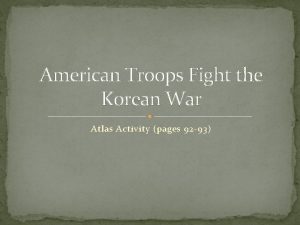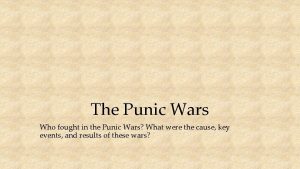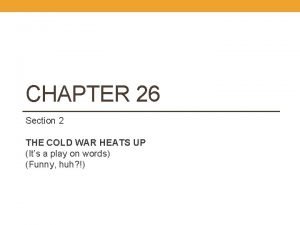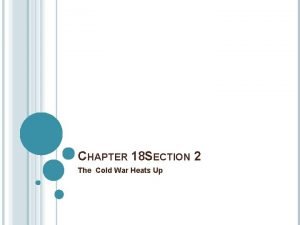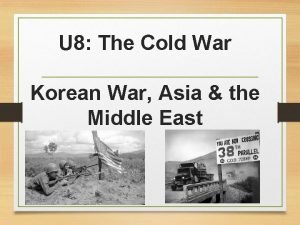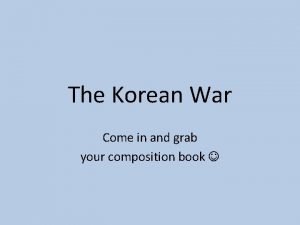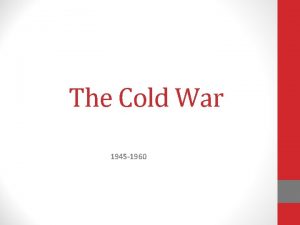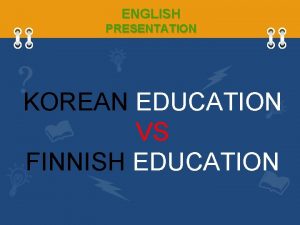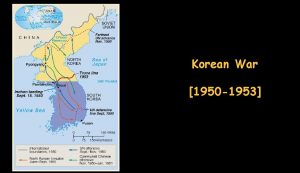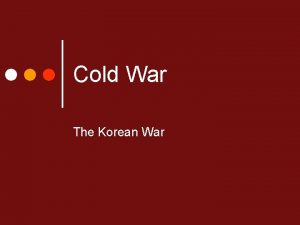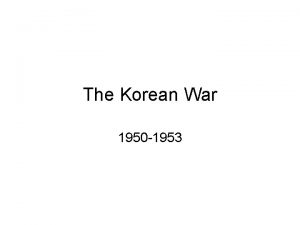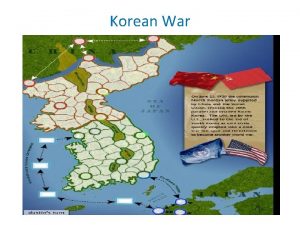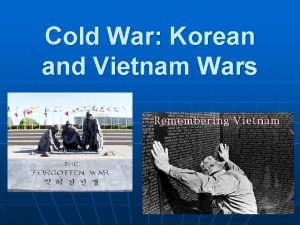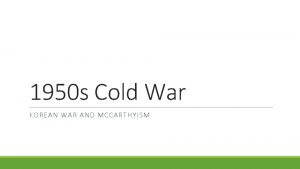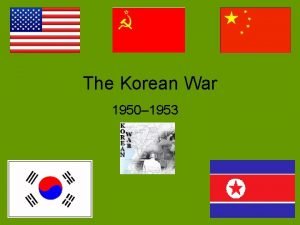Key Cold War Events The Korean War 1950












- Slides: 12

Key Cold War Events

The Korean War (1950 -1953) • after Japan’s surrender the north of Korea was occupied by USSR, the South by USA, both sides set up friendly gov’ts in their halves. 1950 – N. Korea invades the South. • UN security council votes to send troops to help defend the South. (Soviets missed the vote and could not veto) • China, under new communist leader, Mao Zedong, helps N. Korea push back the U. S. -led troops. • Results: - ceasefire signed in 1953 after Stalin’s death. Neither side gains much, but U. S. is happy it “contained” the spread of communism for the moment. Animation of the War

A-26 Invaders bomb supply warehouses in Wonsan, North Korea, 1951.

• While trains were used to transport U. S. Soldiers and their equipment during the Korean War, trains in North Korea were targets of attack by U. S. and other U. N. forces. Here, U. S. forces target rail cars south of Wonsan, North Korea, an east coast port city.

Nikita Khruschev • Leader of USSR after Stalin dies • Introduces “De-Stalinization” policies. For the first time the Soviet people are told the truth about many of Stalin’s evil deeds. • Relaxation of secret police and use of labor camps, some restrictions on society are lifted. • Khruschev tries to improve living conditions for citizens but growth is slow. • Khruschev offered aid to many third-world nations beginning to industrialize hoping to counter American influence • 1956 – Hungarian uprising against Communist rule is crushed by Soviet army. • 1961 – Berlin Wall is built to prevent East Germans from escaping to West Berlin/West Germany.

Cuban Missile Crisis (1962) • October 1962 – The closest the world has ever come to nuclear war • USSR had installed nuclear missiles in Cuba and authorized their use if the U. S. invaded Cuba. This intruded on the U. S. sphere of influence and U. S. armed forces were on high alert.


• • • Cuban leader Fidel Castro was afraid of U. S. invasion. The U. S. had already tried to overthrow him in 1961 with the Bay of Pigs invasion (failed). Americans had missiles in Turkey to reach the U. S. S. R. – Soviets placed missiles in Cuba to reach North America President Kennedy demanded Khruschev remove the missiles and began a naval blockade of the island to make sure no further supplies would be delivered. Khruschev wanted the U. S. to remove missiles they had in Turkey. In the end, Khruschev backed down after Kennedy guaranteed the U. S. would not invade Cuba. He removed the Soviet missiles and all personnel from the island.

• The Cuban Missile Crisis is an excellent example of the importance of diplomacy in resolving conflicts: – In this case, direct military conflict would have been disastrous, although diplomacy was motivated largely by the concept of M. A. D. (mutually assurred destruction) which existed between the U. S. A. and U. S. S. R. throughout the Cold War. • In the following years, the world’s powers would begin to place limitations on the spread of nuclear weapons.


• After the Cuban Missile Crisis, Khruschev began a policy of “peaceful co-existence. ” This was the decision that the rivalry between superpowers would be a competition in other areas and not an actual war. • Even though he talked about peace between the two sides, he still made threats against the West and continued to develop nuclear weapons. • One of the greatest areas of competition was THE SPACE RACE.

The Space Race • The spirit of exploration and conquest that motivated the discovery of the “New World” in the 15 th century also motivated the superpowers to explore the universe beyond planet Earth. • Oct. 4, 1957 – USSR launches first satellite Sputnik I • Surprises/worries the West, the Space Race was not just a source of national pride but also had military influence. Results in increased technological development on both sides the Space Race • April 12, 1961 – USSR puts the first man in space (Yuri Gagarin) • 1966 – USSR lands the first spaceship (unmanned) on the moon • In the early stages of the Space Race, the U. S. trailed behind the Soviet Union by as much as a year in some major accomplishments. • July 1969 – Apollo 11 mission - U. S. lands on the moon, Neil Armstrong is first man to walk on the moon • Neil Armstrong's famous quote
 Welcome 1 unit 10 lesson 1
Welcome 1 unit 10 lesson 1 Korean war vietnam war venn diagram
Korean war vietnam war venn diagram Presidential and radical reconstruction venn diagram
Presidential and radical reconstruction venn diagram Cold war map activity
Cold war map activity American troops fight the korean war 48a answer key
American troops fight the korean war 48a answer key Sides of the cold war
Sides of the cold war Punic wars who fought
Punic wars who fought Chapter 26 section 2 the cold war heats up answer key
Chapter 26 section 2 the cold war heats up answer key Chapter 18 section 2 the cold war heats up
Chapter 18 section 2 the cold war heats up Korean war webquest
Korean war webquest The causes of the korean war
The causes of the korean war Causes and effects of the korean war
Causes and effects of the korean war Finnish korean war
Finnish korean war




